Bursting at the seams: Singapore's cast-off clothing
SINGAPORE: Racks of brightly coloured clothes line the aisles at the Salvation Army's Family Austerity Store in Tanglin. A mannequin sporting a blackness, curly wig wears a black-and-white printed apparel, while some other models a red clothes with a blackness skinny belt.
The racks are jammed tightly with clothes of varying patterns, sizes and brands, with some obviously brand new with tags still attached.
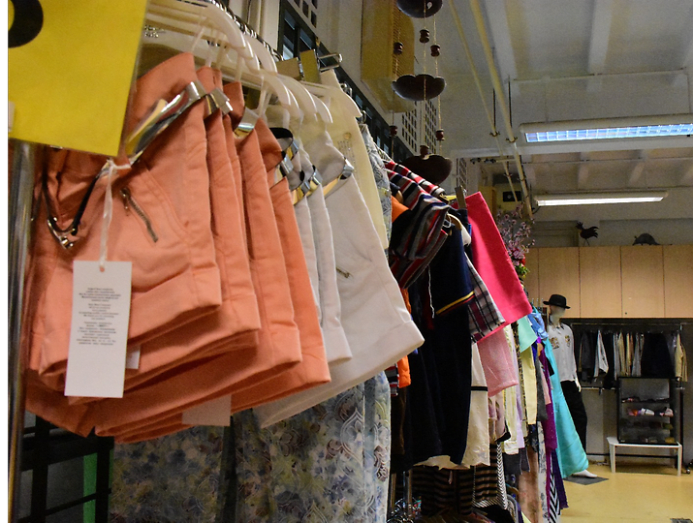
The Salvation Army's Family unit Thrift Store in Tanglin. (Photo: Winnie Goh)
Singaporeans looking to clear their bursting wardrobes often plough to the charity every bit their first port of phone call. Information technology accepts donations of wear, piece of furniture and other items like household goods.
Simply what is displayed in this shop - and in fact beyond their v austerity stores islandwide - is simply a minor fraction of what information technology gets on a daily footing.
On boilerplate, the Salvation Army receives almost 10 tonnes of donated items per day, virtually 60 per cent of which is vesture. The amount can go upwards to almost 30 tonnes a day during peak periods like the month leading upwardly to Christmas.
And the burgeoning mounds of clothes taken in by the charity highlights a larger trouble - the sheer corporeality of cast-off clothing generated by Singaporeans.
BUYING More than NEEDED
According to statistics from the National Surround Agency (NEA), Singapore generated 156,700 tonnes of material and leather waste terminal yr. This category, according to an NEA spokesperson, includes used wearable, linen and bags.
Simply of this amount, only 12,500 tonnes were recycled, which brings Singapore's recycling rate in this category to just viii per cent. NEA said material and leather waste that is "not segregated at source for recycling or reuse" is incinerated.
Singapore's rate appears to be function of a global trouble. In the U.s.a., only well-nigh xvi per cent of textile waste was recycled in 2014, according to a report from the Environmental Protection Bureau. In the UK, it is xiv per cent, according to a written report published last year by the Department of Nutrient, Environment and Rural Affairs, citing 2022 figures.
Reducing the amount of wear waste in Singapore is a challenge, according to Ms Nuramirah Suyin Zaihan, an environmental engineer at the Singapore Environs Quango (SEC). Greater spending power naturally fuels the consumption rate of goods, leading to consumers buying more than than they need, she explained.
"Consumers are unable to see the connectedness between habiliment consumption and the resultant waste that they produce," she said.
The proliferation of fast-style chains in neighbourhood malls may also exist contributing to the issue.
"The emphasis of mass product of such clothing to consumers can upshot in wearing apparel that are of poor quality and are not meant to last long," explained Ms Nuramirah. "These dress volition not only have a low resale value, but have a high chance of ending up as waste."
"The competitive prices and convenience brought about past online shops and marketplaces also accelerate the wearable waste material issue," she added.
Inquiry suggests this could exist a primal factor behind some people's buying habits.
As part of an upcoming documentary The Trash Trail, Channel NewsAsia surveyed 1,000 Singaporeans to find out how much clothing they discard, and why.
Co-ordinate to the results, Singaporeans purchase about 34 pieces of brand new dress per twelvemonth, with about one-half of them citing discounts as the main driver for doing so. And on average, they discard 27 items of habiliment per twelvemonth, citing reasons like "making space for new apparel", "no longer fits" and "there are defects".
LACK OF AWARENESS
People in Singapore are generally not aware of how and where they tin recycle their old apparel, said Ms Nuramirah.
She added that due to a lack of education on proper recycling, cross-contagion of recycling bins is also a problem. "People should practise proper recycling habits by bagging recyclables like clothing waste matter and sealing it thoroughly to avoid whatever cantankerous-contagion," she said.
Dissimilar paper or food waste material, which is thrown away instantly, clothing waste material also tends to accumulate over long periods of fourth dimension and gets discarded in large quantities when people jump-clean their wardrobes.
She added that as a outcome, it is common to find people donating their one-time apparel to charities like the Salvation Regular army.
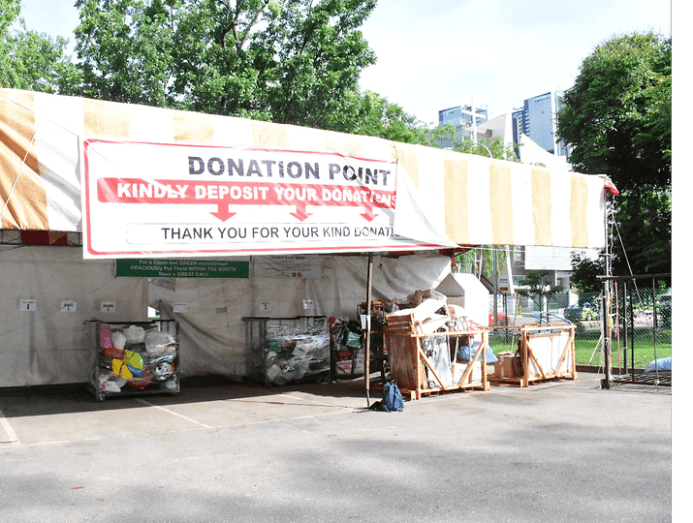
A donation point at the Conservancy Regular army Family Hub in Tanglin. (Photo: Winnie Goh)
TOO MANY CLOTHES
The Salvation Army estimates that just about viii to x per cent of donated clothes will be put on sale to members of the public considering of the sheer number of items they receive.
"We receive then much clothing per day that it'southward impossible for us to put information technology all on display in our shops," said Mr David Lim, senior manager of wholesale and export for Ruddy Shield Industries, the clemency'south social enterprise arm.
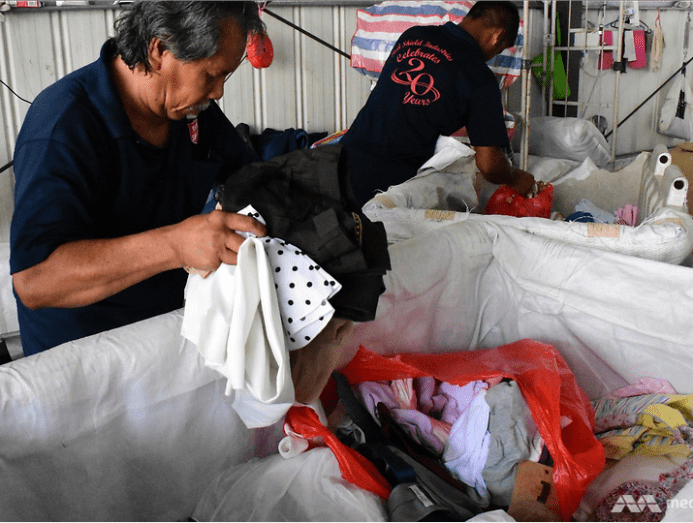
Workers at the Salvation Army sort donated clothing at its fundamental processing centre. (Photo: Winnie Goh)
He explained that the dress on sale at the charity'due south thrift stores have passed two rounds of quality checks - first at the charity's cardinal processing eye, and again at the shop. Whatever does not make the cut volition be returned to the processing centre for export to Malaysia and Republic of indonesia.
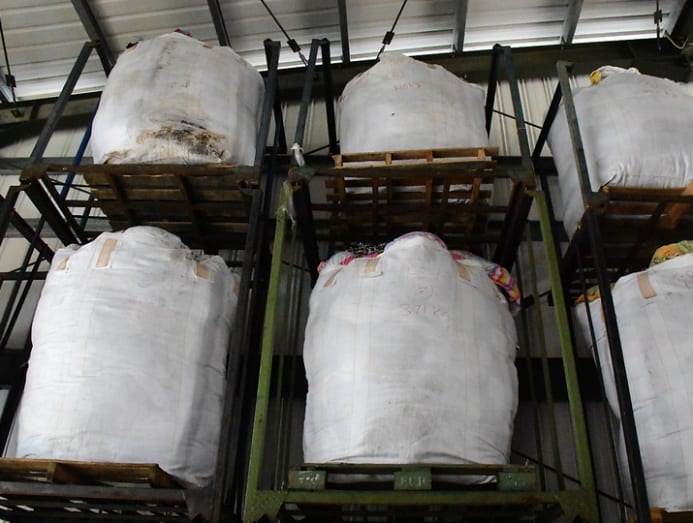
Jumbo bags of donated clothes are prepared for export at the Salvation Ground forces's key processing heart. Each bag holds about 400kg. (Photograph: Winnie Goh)
"The funds we receive will help the Salvation Regular army in transforming lives," he added.
Only while altruistic to charities is ane manner to reduce the corporeality of apparel being thrown abroad in Singapore, Ms Nuramirah noted that "a mindset and lifestyle change is needed".
How can this mindset and lifestyle change be effected? For one woman, the answer comes in the form of a sewing needle.
THE ART OF UPCYCLING
While Singaporeans throng shopping malls looking for the latest cheap clothing, Ms Agatha Lee estimates that she buys new apparel for herself and her family just one time or twice a year.
Instead, she combines her skill with the sewing needle with her passion for the environment and finds ways to plow her old clothes into new items for herself and her abode. She describes the procedure as "upcycling", or turning discarded items into functional products of even higher quality and value.

Ms Agatha Lee was inspired to upcycle her old wearing apparel into new items for herself and her domicile. (Photo: Winnie Goh)
She recounted: "A few years back, I realised I had a lot of wearing apparel in my wardrobe. Initially, I was going to throw them away or donate them, but then I realised it would be such a waste product because while I was clearing out my wardrobe, I would also be ownership fifty-fifty more apparel.
"I browsed on the Internet and realised there was a whole customs of people who were upcycling their wearing apparel, and so that was how I got started."
A look around her Woodlands apartment reveals evidence of her creative flair: A desk chair has been reupholstered with covers fabricated out of an old pair of jeans. Her cat is curled upwardly on a picnic coating made out of scrap material from discarded clothes. And a mannequin displays a halter summit made out of what used to be a pair of trousers.
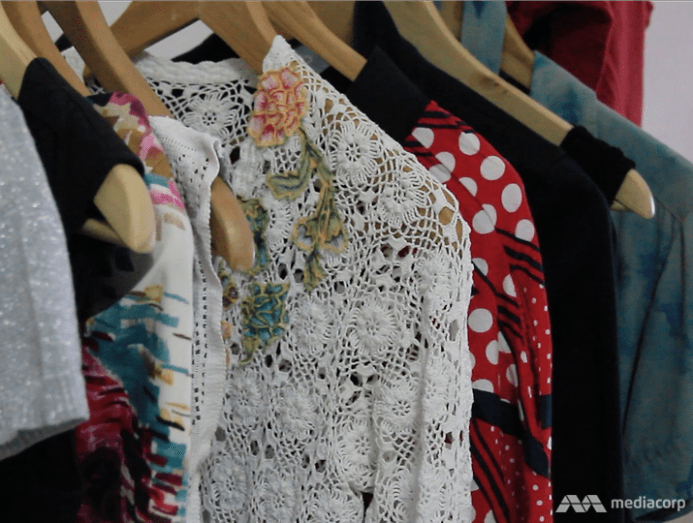
Some of Ms Lee's upcycled creations. (Photo: Winnie Goh)
It was non long before Ms Lee, who works part-fourth dimension, began sharing her upcycling tutorials online. And her friends shortly encouraged her to start running workshops to show Singaporeans how their unwanted clothes tin exist turned into something new.
"I was engaged by a lot of corporates and schools, and terminal yr, I decided to have my ain series of workshops," she said. Participants in her full-day workshop larn the nuts of sewing using a sewing machine, and effort their hand at turning two or three of their own items of clothing into something new.
"At the final workshop, one lady converted her dress into her bag that was actually well done, and there was another lady who had never sewn in her life, and she converted ii of her husband'southward T-shirts into cushion covers, consummate with zips," she recalled.
"You don't need a lot of sewing skills and you don't need to chop up the whole particular to make it into another garment," she added. "It can actually exist a very fun action and doesn't have to take also much time."
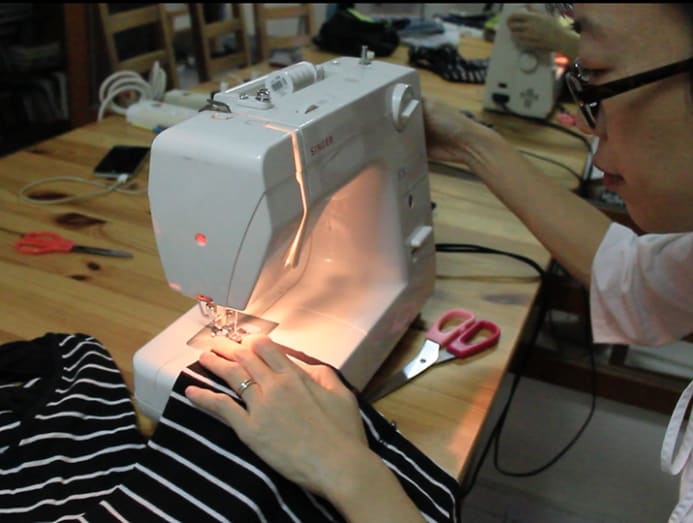
Ms Lee turns half an quondam top into a drawstring bag. (Photo: Winnie Goh)
Just upcycling aside, Ms Lee said the simplest means of reducing the vast amount of clothing waste material Singapore generates is for people to change their mindset and buy fewer clothes. "Even before you lot enter the store, decide whether you even need that item of clothing," she said.
"Because once you lot buy it and find yous don't want to wear information technology anymore, you're probably going to end up throwing information technology into the bin."
SECOND-Hand Outset
And that is where one business comes in - to save good clothing from the bin and in the procedure, save people some money.
With warm lighting and pop music blasting through the store, the flagship Refash outlet at City Plaza resembles any other shop in the mall selling clothes targeting young fashionable women looking for a adept bargain.
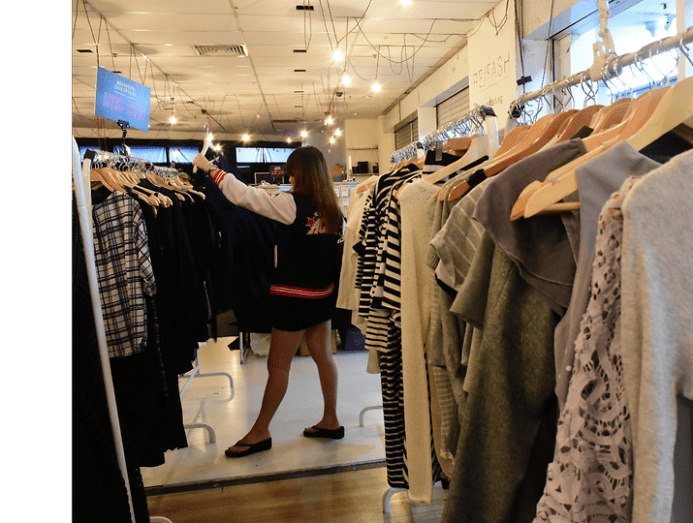
The flagship Refash shop at Metropolis Plaza. (Photo: Winnie Goh)
But there is one divergence - everything for sale on the racks is second-hand, and going for a fraction of its original toll. A beige knit sweater from Uniqlo costs Due south$10, while a blackness flare dress from New Expect sells for Southward$12.
Refash founder Aloysius Sng hopes to provide a simple solution for what he described as "a real problem in the marketplace": That people do not wear a lot of items in their closet. He noted that a lot of these items also tend to be in almost mint condition and withal on-tendency.
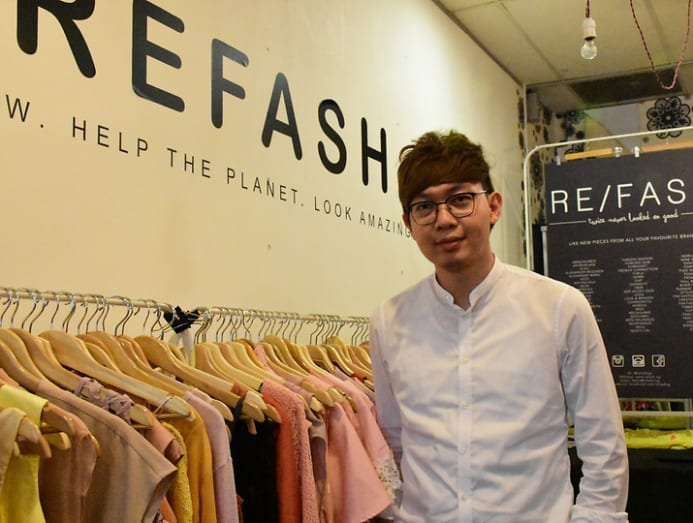
Refash founder Aloysius Sng. (Photo: Winnie Goh)
"With shortening trends and fast-fashion brands producing new designs faster than always, that also means that consumers are consuming fast-fashion faster than ever," he said. "Nosotros make it extremely elementary for ladies to make clean out their wardrobe, by just stuffing all their unwanted clothes in a handbag, passing it to us, and we'll do the balance."
Wearing apparel that reach Refash are sorted, tagged and either put on the racks at one of the company's physical stores or listed on their website for auction, explained Mr Sng. The visitor takes a small service fee for each auction. "Nosotros accept mostly fast-fashion brands similar H&Yard, Uniqlo, Topshop and Zara, and local brands similar Love Bonito and MDS."
"The dress simply have to exist on-trend and in similar-new status," he added.

Bags of wearing apparel waiting to be sorted and tagged past Refash staff. (Photo: Winnie Goh)
Refash accepts about lxxx per cent of the wearing apparel information technology receives, he added. Clothes that are rejected upon sorting or are non sold after some time are either returned to the seller, donated to clemency or exported overseas for sale.
Over the last 9 months, Refash has processed more 80,000 pieces of vesture and made about one-half a million dollars in sales revenue. And Mr Sng said there is a waiting list of more than 1,000 people looking to sign up with them.
He said these are encouraging signs that Singaporeans are becoming more open up to the thought of buying and wearing second-manus clothes. "Just three weeks ago, nosotros had a warehouse auction … and a stream of people queuing upward to shop for second-hand clothes. It just goes to evidence that when second-hand is presented in a manner that hasn't been done before, people are receptive to information technology."
"We can't say for sure that we've reduced cloth waste by 10 or xx per cent, but it's a small-scale pace towards a longer term vision … to inspire a new generation of consumers to always think second-hand first," he added.
The Trash Trail volition be aired on Aqueduct NewsAsia on Jan 31 at 8pm.
Source: https://cnalifestyle.channelnewsasia.com/singapore/bursting-seams-singapores-cast-clothing-294801
0 Response to "Bursting at the seams: Singapore's cast-off clothing"
Post a Comment